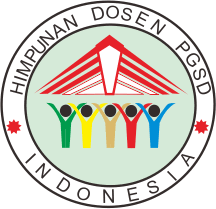Penerapan model pembelajaran berbasis proyek (project-based learning) untuk meningkatkan keterampilan berpikir kreatif pada pembelajaran IPAS di Sekolah Dasar
Abstract
The purpose of this study: (1) to explain the implementation of PjBL models in the context of IPAS (integrated science and social studies) learning of fourth grade elementary school Pajang IV Surakarta in the academic year 2022/2023. (2) to enhance creative thinking skills of fourth grade elementary school Pajang IV Surakarta. This research employs classroom action research approach. The subjects of this study were teacher and student of fourth grade elementary school Pajang IV Surakarta. The methods for gathering data included observation, interviews, documentation, and a test assessing creative thinking. Techniques for ensuring data validity involved the utilization of triangulation methods and source triangulation. The data analysis method consists of four stages: 1) data collection, 2) data reduction, 3) data presentation, and 4) drawing conclusions. The classroom action research procedure consists of planning, action, observation, and reflection. This research findings indicate that: (1) implementing the PjBL model to enhance creative thinking skills involves several steps, such as formulating fundamental questions, designing project plans, creating schedules, monitoring progress, assessing outcomes, and evaluating the overall experience. This improvement occurs over three instructional cycles, suggesting that the PjBL model can enhance creative thinking skills of fourth grade elementary school Pajang IV the academic year 2022/2023.
Keywords
Full Text:
PDFReferences
[1] S. Yunianingrum, I. R. W. Atmojo, and Hadiyah, “Peningkatan keterampilan menyimpulkan melalui model pjbl (project based learning) pada pembelajaran IPA,” Didaktika Dwija Indria,
7 (7), 24–29, 2019.
[2] R. Nurdianti, I. R. W. Atmojo, and Sularmi, “Penerapan metode edutainment berbasis guided discovery learning untuk meningkatkan keterampilan menyimpulkan pada pembelajaran ipa kelas iii sekolah dasar,” Didaktika Dwija Indria, 8 (4), 47–53, 2020.
[3] Z. Zulfah, A. Astuti, D. Ezaldy, E. H. Firmansyah, et al., “Meta Analisis: High Order Thinking Skills,” Journal on Education, 4 (3), 891–896, 2022.
[4] I. W. Widana, Modul penyusunan soal HOTS. Jakarta: Direktorat Pembinaan SMA Direktorat Jenderal Pendidikan Dasar Dan Menengah Departemen Pendidikan dan Kebudayaan, 2017.
[5] Partnership for 21st Century Skills, “Core Content Integration Framework for 21st Century Learning,” Battelleforkids., pp. 1-70, 2015. [Online]. Available: www.P21.org.
[6] M. Agustin and Y. A. Pratama, Keterampilan Berpikir Dalam Konteks Pembelajaran Abad Ke-21. Bandung: Refika Aditama, 2021.
[7] U. Munandar, Pengembangan Kreativitas Anak Berbakat. Jakarta : Rineka Cipta, 2014.
[8] N. Marliani, “Peningkatan Kemampuan Berpikir Kreatif Matematis Siswa Melalui Model Pembelajaran Missouri Mathematics Project (MMP),” Jurnal Formatif., 5 (1), 14–25, 2015.
[9] A. Fitri, A. A. Rasa, A. Kusumawardhani, K. K. Nursya’bani, et al, Ilmu Pengetahuan Alam dan Sosial, Jakarta: Badan Penelitian, Pengembangan dan Perbukuan Kementerian Pendidikan, Kebudayaan, Riset, dan Teknologi, 2021.
[10] R. Florida, C. Mellander, and K. King, “The Global Creativity Indeks,” Martin Prosperity Institute., pp. 1–64, 2015. [Online]. Available: https://www-2.rotman.utoronto.ca/mpi/wp-content/uploads/2015/07/Global-Creativity-Index-2015.pdf
[11] S. Dutta, B. Lanvin, L. R. Leon, dan S. W. Vincent, " Global Innovation Index 2021 ", World Intellectual Property Organization. pp 1-226, 2021, [Online]. Available: https://www.wipo.int/global_innovation_index/en/
[12] L. Wahyuni dan Y. S. Rahayu, “Pengembangan E-Book Berbasis Project Based Learning (PjBL) untuk Melatihkan Kemampuan Berpikir Kreatif pada Materi Pertumbuhan dan Perkembangan Tumbuhan Kelas XII SMA,” Jurnal BioEdu., 10 (2), 314–325, 2021.
[13] S. Hadi dan Novaliyosi, “TIMSS INDONESIA (Trends In International Mathematics And Science Study),” Prosiding Seminar Nasional., pp. 100–108, Jan. 19, 2019.
[14] A. S. Muhammad dan I. R. W. Atmojo, “Peningkatan Keterampilan Fluency Melalui Penerapan Model Pembelajaran Project Based Learning (PjBL) Pada Pembelajaran IPA Di Sekolah Dasar,” Jurnal Pendidikan Dasar, 6 (1), 42–47, 2018.
[15] A. Fitriyah and S. D. Ramadani, “Pengaruh Pembelajaran STEAM Berbasis PjBL ( Project-Based Learning ) Terhadap Keterampilan Berpikir Kreatif dan Berpikir Kritis,” Journal Of Chemistry And Education., 10 (1), 209–226, 2021.
[16] A. Ulinnuha, “Penerapan Project Based Learning pada Materi Protista Untuk Meningkatkan Keterampilan Berpikir Kreatif Siswa Kelas X MIPA 5 SMA Batik 1 Surakarta,” Skripsi Universitas Sebelas Maret, 2021.
[17] R. N. Phasa, “Penerapan Model Project Based Learning untuk Meningkatkan Kreativitas Siswa pada Pembelajaran IPS Tema 7 Indahnya Keragaman di Negeriku pada Siswa Kelas IV SDN 1 Kutosari Tahun Ajaran 2021/2022,” Skripsi Universitas Sebelas Maret, 2022.
[18] H. C. Kuo, Y. T. C. Yang, J. S. Chen, T. W. Hou, dan M. T. Ho, “The Impact of Design Thinking PBL Robot Course on College Students’ Learning Motivation and Creative Thinking,” IEEE Trans. Educ., 65 (2), 124–131, 2022.
[19] S. Y. Chen, C. F. Lai, Y. H. Lai, and Y. S. Su, “Effect of project-based learning on development of students’ creative thinking,” International Journal of Electrical Engineering & Education., 59 (3), 232–250, 2022.
[20] S. Arikunto, Suhardjono, dan Supardi, Penelitian Tindakan Kelas. Jakarta: Bumi Aksara, 2014.
[21] M. Fathurrohman, Model-model Pembelajaran Inovatif: Alternatif Desain Pembelajaran yang Menyenangkan. Yogyakarta: Ar-Ruzz Media, 2015.
[22] Trianto Ibnu Badar Al-Tabany, Mendesain Model Pembelajaran Inovatif, Progresif, dan Kontekstual. Jakarta: Prenadamedia Group, 2014.
Refbacks
- There are currently no refbacks.



